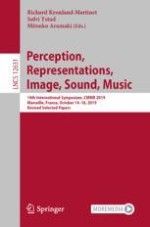This book constitutes the refereed proceedings of the 14th International Symposium on Perception, Representations, Image, Sound, Music, CMMR 2019, held in Marseille, France, in October 2019.
The 46 full papers presented were selected from 105 submissions. The papers are grouped in 9 sections. The first three sections are related to music information retrieval, computational musicology and composition tools, followed by a section on notations and instruments distributed on mobile devices. The fifth section concerns auditory perception and cognition, while the three following sections are related to sound design and sonic and musical interactions. The last section contains contributions that relate to Jean-Claude Risset's research.
